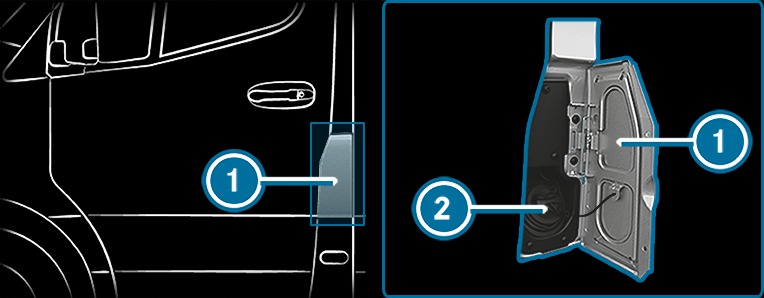Fuels are highly flammable.
Fuels are poisonous and hazardous to your health.
If you or other people come into contact with fuel, observe the following:
Electrostatic charge can ignite fuel vapour.
Vehicles with a diesel engine:
If you mix diesel fuel with petrol, the flash point of the fuel mixture is lower than that of pure diesel fuel.
While the vehicle is running, component parts in the exhaust system may overheat without warning.
Do not switch on the vehicle. Otherwise, fuel can enter the fuel system.
Even small amounts of the wrong fuel could result in damage to the fuel system and the engine. The repair costs are high.
If fuels are handled improperly, they pose a danger to persons and the environment.
The vehicle is unlocked.
The auxiliary heating is switched off.
The vehicle is switched off.
The front left-hand door is open.
Do not get back into the vehicle during the refuelling process. Otherwise, electrostatic charge could build up again.
Observe the notes on operating fluids More.



The fuel filler flap is beside the front left-hand door when viewed in the direction of travel. The position of the fuel filler cap is also shown on the instrument cluster  . The arrow on the filling pump specifies the side of the vehicle.
. The arrow on the filling pump specifies the side of the vehicle.
 .
.  anti-clockwise and remove it.
anti-clockwise and remove it.  and turn it clockwise.
and turn it clockwise. You will hear a click when the fuel filler cap is closed fully.
 .
. Vehicles with a diesel engine and incorrect fuelling protector against refuelling with petrol: the filler neck is designed for refuelling at diesel filling pumps for passenger vehicles.
Vehicles with a diesel engine without an incorrect fuelling protector: refuelling preferred at diesel filling pumps for passenger vehicles. However, you can also refuel at a diesel filling pump for lorries.
If the fuel tank has been run completely dry, top up with at least 5 l of fuel.
Vehicles that can use a mixture of fuels can be recognised by the sticker "Ethanol up to E85!" on the fuel filler flap.

